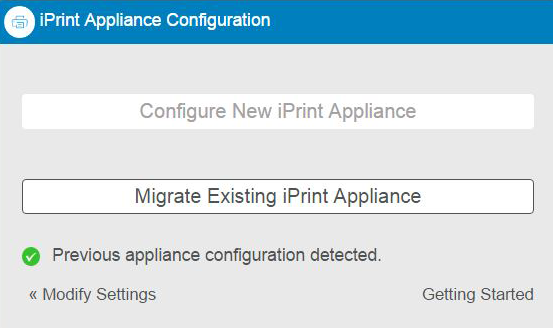6.1 Migrating from iPrint Appliance 2.x to 3.0
When migrating an appliance the data from the secondary disk of earlier appliance is used to setup the new appliance. We only support disk-based migration from 2.x to 3.0 versions. The earlier versions (1.x) cannot be migrated directly to 3.0 due to changes in the schema. These changes were done to provide enhanced features. You must migrate 1.x to 2.0 using zip file and then migrate to 3.0.
6.1.1 Support Matrix
You must upgrade to the latest supported patch version before migrating to iPrint Appliance 3.0.
Table 6-1 iPrint Source Version Support for Migration
|
Source Version |
Patch Version |
Status |
|---|---|---|
|
2.1 |
patch 3 or later |
Supported |
|
2.0 |
patch 5 |
Supported |
|
1.1 |
Not Supported. Migrate to 2.x. |
|
|
1.0/ 1.0.1 |
|
Not Supported. Migrate to 1.1, then 2.x. |
6.1.2 Prerequisites
Failure to comply with any of the following critical points can result in a non-functional iPrint Appliance.
-
Secondary disk that includes the configuration file (iprintconfig.zip) of the earlier version.
-
Print pending jobs: Ensure to print or cancel any pending jobs.
-
Remove all snapshots prior to upgrading an appliance: To ensure that correct disk file and the latest configuration settings get migrated.
-
Meet all hardware and software requirements: See Section 3.0, Planning Your Print Environment.
-
Patch the appliance: See Field Patch.
-
You cannot migrate directly from iPrint 1.1, 1.0 or 1.0.1 to iPrint 3.x: You must first migrate to iPrint Appliance 2.x, apply all patches, ensure that all desktop clients are updated, and then upgrade to iPrint Appliance 3.x.
6.1.3 Migration Process
-
Shut down the earlier appliance. The new appliance will be configured with the same IP and network settings.
-
Deploy iPrint Appliance with any virtualization software that can run the .ovf, .vhd , or .xen file formats.
-
Attach the secondary disk of the earlier version of the appliance. This disk includes the configuration file (iprintconfig.zip) of the earlier appliance.
-
Power on the appliance.
-
On the Console tab, enter the root and vaadmin password for the new appliance.
The iPrint Appliance installation is now complete.
-
On a Web browser, use either the host name or the IP Address to access the Management Console. For example, https://10.0.0.1:9443 or http://iprint.example.com/admin.
Ignore the security certificate warning, and continue to the iPrint Appliance Management Console. To avoid the security warning prompt every time you access the iPrint Appliance Management Console, you can add the certificate to the trusted certificates list on your browser.
-
Specify vaadmin or root as the user name.
-
Specify the password, then click Log in.
-
Click Migrate Existing iPrint Appliance.

-
The iManager user name field is pre-populated and not editable. Specify the iManager password that was used to configure the earlier version of the iPrint Appliance. This password will be used to log in to the iManager for managing the print environment.

-
Click Finish.
The time taken to complete the configuration depends on the size of the earlier version configuration file. On successful migration, the appliance reboots the VM.
The configuration file of the previous appliance is renamed as previous_iprintconfig.zip.
6.1.4 Post-Migrate
-
If you have an existing remote renderer, then post-migration of appliance, the renderer might be in an inactive state. To make the renderer active, stop and restart the renderer. After activating the renderer you must upgrade it. For more information, see Upgrading the Remote Renderer.